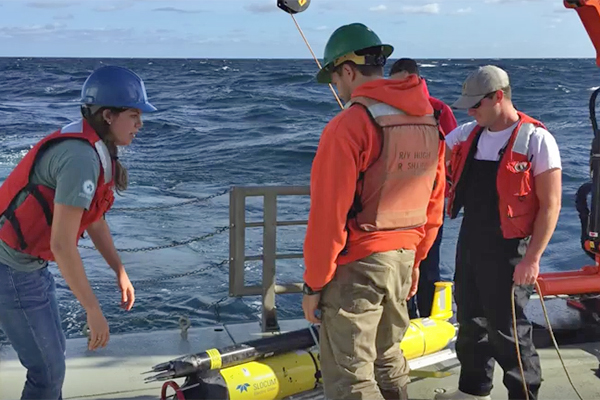Science at sea
UD researchers mentor early career scientists on using robotics to maximize fieldwork at sea
2:32 p.m., Dec. 8, 2015--Nine early career marine scientists from institutions across the nation spent seven days aboard the University of Delaware’s R/V Hugh R. Sharp training to become chief scientists and to use robotics to maximize research opportunities at sea.
The R/V Hugh R. Sharp, UD’s 146-foot, state-of-the-art coastal research vessel, is a member of the University-National Oceanographic Laboratory System (UNOLS). The early career scientists represented Massachusetts Institute of Technology (MIT), Dartmouth and Woods Hole Oceanographic Institution (WHOI), among other institutions.
Research Stories
Chronic wounds
Prof. Heck's legacy
The UNOLS Chief Scientist Training Cruise, held Nov. 17-23 and sponsored by the National Science Foundation and the Office of Naval Research, was designed to instruct early career marine scientists, including doctoral students, faculty and researchers, on how to effectively plan for — and lead — fieldwork at sea for multi-disciplinary research and education.
Using robotic and autonomous systems aboard UNOLS vessels is increasing and these systems require additional consideration in mission planning, deployment, monitoring, recovery and communications, beyond traditional shipboard operations.
UD’s College of Earth, Ocean, and Environment (CEOE) was selected to lead the seven-day training cruise because of its national expertise in robotics, a main focus of the excursion.
CEOE opened the Robotics Discovery Laboratory (RDL) in 2014. The RDL fleet includes more than a dozen robotic systems, including unmanned underwater vehicles (UUVs) and unmanned aerial vehicles (UAVs), which have been deployed in aquatic research missions all over the world.
“Going to sea is the most rewarding and challenging part of what we do. From a teaching aspect, it’s about learning to make decisions in a changing environment,” said UD associate professor Art Trembanis, who led the cruise.
While at sea, the researchers were faced with a variety of weather conditions, from high winds to wave swells to calmer seas, enabling the workshop participants to quickly try out their new skills.
“The best lessons come from days like we had on this cruise — marginal weather conditions that are not enough to shut down operations, but have enough challenges to require decision making about what research can or cannot go forward,” said Trembanis.
Equally important were lessons in how to interact with the crew and other scientists in the party.
“We all come from different backgrounds; I’m a physicist, there were biologists, chemists, engineers, etc. Being able to talk about what you are doing, how a deployment will go, and what you are trying to accomplish in the midst of other people with different objectives is a great experience,” said Sophia Merrifield, a graduate student studying physical oceanography in the MIT/WHOI Joint Program.
Troubleshooting and adaptability play a role, too. “Mine was the first deployment of a vehicle and it didn’t go so well. We sustained some damage to the glider, but we got it back; we’ll try to rebuild it and learn from our experience,” Merrifield said.
During the cruise, the researchers used a tethered ROV to survey the USS Arthur W. Radford, the largest artificial reef on the East Coast. Using video cameras aboard the ROV, they saw fish and mussels that have made the reef their home, and were able to better characterize the reef.
While there, Trembanis challenged the group to design a tool to sample the bottom sediments at the site.
“A few hours later we had not one, but two instruments designed, built and tested to sample the bottom sediments of the location; all while at sea,” Trembanis said.
Summing things up, Ryan Portner, a post-doctoral research associate at Brown University with an interest in marine volcanoes and sedimentology, said he appreciated the opportunity to view problems from different angles.
“It’s important to step back from the science I’m doing in order to explore the other potential that’s out there and how I can apply that to what I do. It was interesting to learn how AUV and ROV operations work, why we use them, and to consider how I can employ these technologies in the work that I do. For example, using AUVs to explore the sea floor, sample different rocks on different volcanoes and map volcanoes with very high detail,” he said.
Interestingly, six of the nine participants were female scientists. “I was thrilled to have such a diverse group, especially representing women in the STEM (science, technology, engineering and mathematics) fields. I hope to see more of this kind of diversity among our chief scientists going forward,” Trembanis said.
Other scientists who participated in the training workshop included:
- Willie Flemings and Kerri Whilden, Texas A&M University Geochemical and Environmental Research Group;
- Samuel Georgian, Temple University, Department of Biology;
- Amy Mueller, University of Washington, School of Oceanography;
- Rachel Obbard, Thayer School of Engineering, Dartmouth;
- Mei Sato, Oregon State University, College of Earth, Ocean, and Atmospheric Sciences; and
- Sarah Webster, University of Washington, Applied Physics Lab.
Funding
Funding for the cruise was provided through NSF OCE – 1433236 $89,397 plus five days of ship time ~$70,000. The Office of Naval Research funded two of the days at sea.
Article by Karen B. Roberts
Video by Leah Dodd











